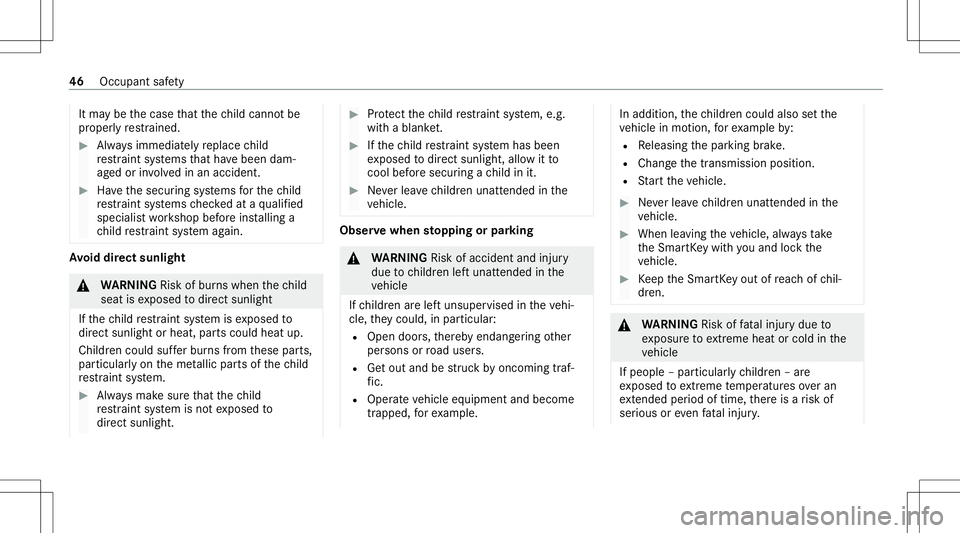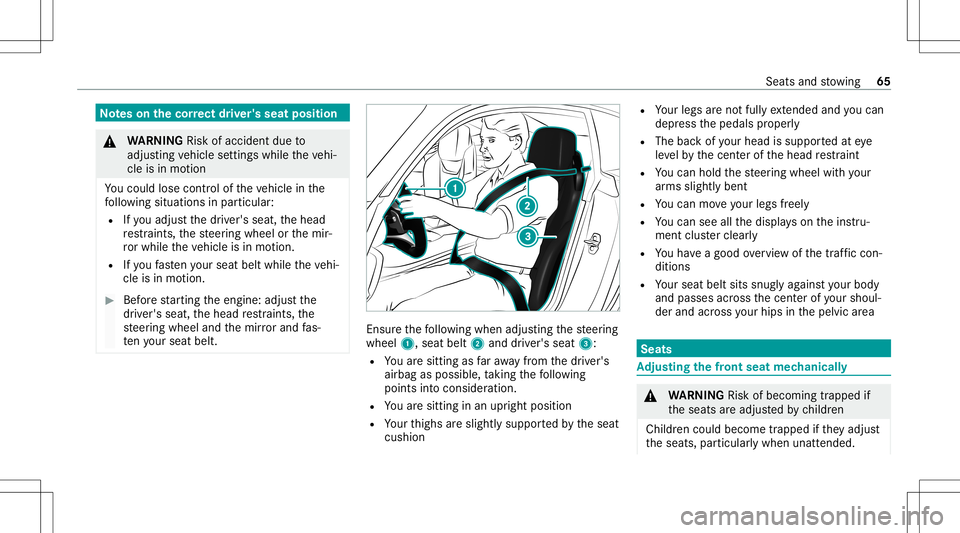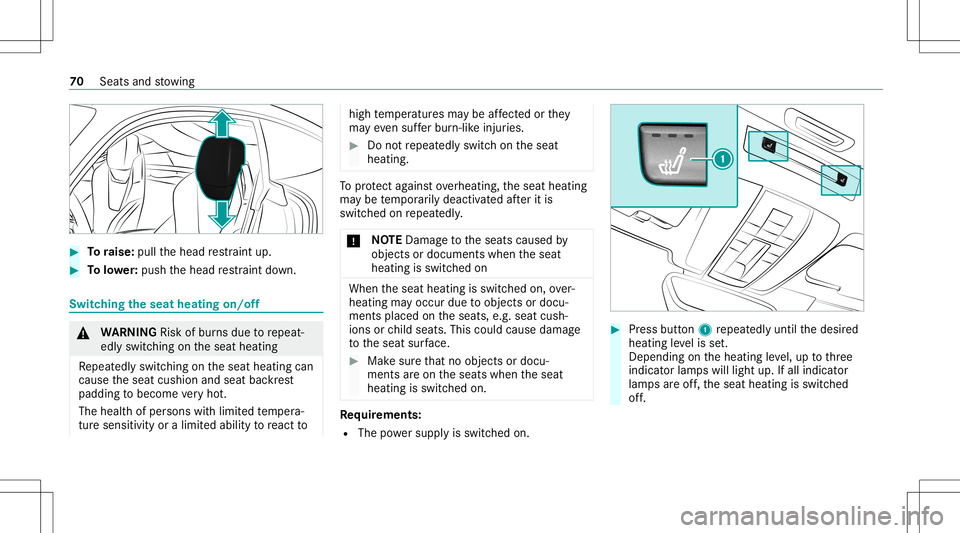2021 MERCEDES-BENZ GT COUPE child seat
[x] Cancel search: child seatPage 46 of 422

The
gener icterm child restra int system
The gener icterm child restra int system isused
in this Oper ator's Manual. Ach ild restra int sys‐
te m is, forex am ple:
R abab ycar seat
R are ar wa rd-faci ng child seat
R afo rw ard-f acin gch ild seat
R ach ild boos terseat withabac kres tand seat
belt guide
The child restra int system mus tbe appr opriate
to theag e, we ight andsize ofthech ild.
Obser velaws and legalrequ irement s
Alw aysobser vetheleg alrequ iremen tswhen
using ach ild restra int system intheve hicle.
Obser vestandar dsforch ild restra int sys‐
te ms
All child restra int systems mustmee tth efo llo w‐
ing standar ds:
R U.S. Feder alMo torVe hicle SafetySt andar ds
21 3and 225 R
Canadi anMo torVe hicle SafetySt andar ds
21 3and 210.2
Conf irmatio nth at thech ild restra int system
com plies withth est andar dscan befound onan
ins truct ion label onthech ild restra int system.
This confirm atio ncan also befound intheins tal‐
lation instruct ions that areinc luded withth e
ch ild restra int system. De
tectin grisk s,avo iding danger Secur
ingsystems forch ild restra int systems
in theve hicl e
Onl yuse thefo llo wing secur ingsystems forch ild
re stra int systems:
R The vehicle's seatbeltsystem
A boos terseat maybe necessar yto achie ve
pr oper seatbeltposition ingforch ildr enover
40 lbs (18 kg )in we ight orunt ilth ey reac ha
heigh twher eath re e-point seatbeltcanbefas‐
te ned prop erly wit hout aboos terseat.
Mer cedes-Benz recomme ndsasu itab lech ild
boos terseat withabac kres tand seat beltguide. Ad
vantag eof are ar wa rd-faci ng child
re stra int system
It is prefer able totrans portabab yor asmall
ch ild inasuit able rear wa rd-faci ng child restra int
sy stem. Inthis case, thech ild sits intheoppo‐
sit edir ect ion tothedir ect ion oftrav el and faces
ba ckwa rds.
Babies andsmall childr enhave com parativ ely
we ak nec kmusc lesinrelation tothesize and
we ight oftheir head. Therisk ofinjur yto thecer‐
vical spine during anacciden tcan bereduced in
a re ar wa rd-facin gch ild restra int system.
Alw ayssecur each ild restra int system cor‐
re ctl y &
WARNIN GRisk ofinju ryor deat hdue to
inc orrect ins tallation ofthech ild
re stra int system
The child can then notbe protect edor
re stra ined asintended . #
Besureto com plywith themanuf actur‐
er's installation instruct ions forth e 44
Occupant safety
Page 47 of 422

ch
ild restra int system and itscor rect
us e. #
Makesur eth at theent ire base ofthe
ch ild restra int system alwaysre stson
th esitt ing surface oftheseat. #
Neverpla ceobjects (e.g.cushi ons)
under orbehi ndthech ild restra int sys‐
te m. #
Use child restra int systems onlywit h
th eor iginal coverdesi gned forth em. #
Alw aysre place damag edcovers wit h
ge nui ne covers. &
WARNIN GRisk ofinju ryor deat hdue to
uns ecur edchild restra int systems inthe
ve hicle
If th ech ild restra int system isincor rectl y
ins talled ornotsecur ed,itcan com eloose.
The child restra int system could beflung
ar oun dand hitvehicle occupants. #
Alw aysins tallch ild restra int systems
cor rectl y,eve nwh en notin use. #
Alw ayscom plywit hth ech ild restra int
sy stem manuf acturer'sinstallation
ins truct ions . R
Alw aysobser vethech ild restra int system
manuf acturer'sinstallation andopera ting
ins truct ions aswellas theve hicle-specif ic
inf ormation:
- Secur ingthech ild restra int system with
th eseat beltonthefront passeng erseat
(/ page48). Obser vethespecif ic
ins truction sfo rth ere ar wa rd-faci ng and
fo rw ard-f acin gch ild restra int systems
(/ page48).
If th efront passeng erseat isoccupied,
ensur e,bo th bef oreand during thejour‐
ne y,that thest atus ofthefront
passeng erairbag iscor rect forth ecur‐
re nt situa tion(/ page 40).
R Obse rveth ewa rning labels intheve hicle
int erior and onthech ild restra int system. Do
notmodif yth ech ild restra int system &
WARNIN GRisk ofinju rydue tomodif i‐
cations tothech ild restra int system
The child restra int system can nolong er
func tion proper ly.Thi spos esan incr eased
ri sk ofinjur y. #
Nevermodify ach ild restra int system. #
Onlyaf fix acce ssories whic hha ve been
speciall yappr oved forth is ch ild
re stra int system bythech ild restra int
sy stem's manuf acturer. Onl
yuse child restra int systems whichar ein
pr oper working condit ion &
WARNIN GRisk ofinju ryor deat hcaused
by theuse ofdamag edchild restra int
sy stems
Child restra int systems ortheir retainin gsy s‐
te ms that have been subjec tedto stre ss in
an accident mayno tbe able toper form their
int ended protect ive func tion. Occ
upant safety 45
Page 48 of 422

It
ma ybe thecase that thech ild can notbe
pr oper lyrestra ined. #
Alw aysimmediat elyre place child
re stra int systems that have been dam‐
ag ed orinvo lved inan acc ident . #
Have thesecur ingsystems forth ech ild
re stra int systems checkedat aqu alif ied
spec ialistwo rkshop beforeins talling a
ch ild restra int system again. Av
oid direct sunli ght &
WARNIN GRisk ofburnswhen thech ild
seat isex posed todirect sunlight
If th ech ild restra int system isex posed to
dir ect sunlight orheat, partscould heatup.
Childr encould sufferbur nsfrom these parts,
par ticular lyon theme tallic partsof thech ild
re stra int system. #
Alw aysmak esur eth at thech ild
re stra int system isno tex posed to
dir ect sunlight . #
Protect thech ild restra int system, e.g.
wit hablank et. #
Ifth ech ild restra int system has been
ex posed todirect sunlight ,allo witto
cool beforesecu ring ach ild init. #
Neverlea vechildr enunat tende din the
ve hicle. Obser
vewhen stopping orpar king &
WARNIN GRisk ofacci dent andinjury
due tochildr enleftunat tende din the
ve hicle
If ch ildr enarelef tunsuper visedintheve hi‐
cle, they cou ld,in pa rticular :
R Open doors,ther eb yendang ering other
per sons orroad user s.
R Getout and bestru ck byoncom ingtraf‐
fi c.
R Ope rate vehicle equipment andbecome
tr apped, forex am ple. In
addit ion,th ech ildr encould alsosetth e
ve hicle inmo tion, forex am ple by:
R Releasing thepar king brak e.
R Chang eth etransmission position.
R Startth eve hicle. #
Neverlea vechildr enunat tende din the
ve hicle. #
When leaving theve hicle, alwaysta ke
th eSmar tKey wit hyo uand lockth e
ve hicle. #
Keep theSmar tKey out ofreac hof chil‐
dr en. &
WARNIN GRisk offata linj urydue to
ex posur eto extreme heat or col din the
ve hicle
If people –par ticular lych ildr en–ar e
ex posed toextreme temp eratur esover an
ex tende dpe riod oftime, ther eis arisk of
ser ious oreve nfa ta linj ury. 46
Occupant safety
Page 49 of 422

#
Neverlea veanyone –pa rticular lych il‐
dr en –unat tende din theve hicle. #
Neverlea veanim alsintheve hicle unat‐
te nde d. Ov
erview ofsuita bleseat sin theve hicl efo r
ins talling ach ild restra int system Fr
ont passeng erseat, secur ingsystem:
0076 Ve
hicle seatbelt
Obser vethespecif icins truction sfo rth e
re ar wa rd-faci ng and forw ard-f acin gch ild
re stra int systems. Ifth efront passeng er
seat isoccupied, ensure,bo th bef oreand
dur ing thejour ney,that thest atus ofthe
fr ont passeng erairb agiscor rect forth e
cur rent situa tion(/ page 40).
Obse rveth eno teson aut omatic front
passeng erairbag shutoff(/ page38) Ac
tiv atin gor deac tivatin gthe child seat
saf etyfe atur eof theseat belt &
WARNIN GRisk ofinju ryor deat hif a
seat beltisunf astened while th eve hicle
is in mo tion
If th eseat beltisreleased whiletheve hicle is
in mo tion, thech ild safetyloc kis deac tiva ted
and thech ild restra int system isno long er
cor rectly secu red. The seat beltisretract ed
sl ig htly bytheiner tiareel and cann otbe
immediat elyfastened again. #
Stop theve hicle immediat elyinaccor d‐
ance withth etraf fic condi tions. #
Activateth especial seatbeltretract or
ag ain and correctl ysecu rethech ild
re stra int system. When
enabled, thech ild seat safetyfe atur e
ens ures that theseat beltofthefront passeng er
seat does notslac kenonce thech ild restra int
sy stem issecur ed.
The seat beltonthefront passeng erside is
eq uipped withach ild seat safetyfe atur e. #
Toins tall ach ild restra int system: when
ins talling ach ild restra int system, always
obser vethemanuf acturer'sinstallation and
opera tingins truct ions aswellas theinf orma‐
tion inthis Oper ator's Manual. #
Pull theseat beltsmoo thly from theseat belt
outle t. #
Engage theseat belttongu ein theseat belt
buc kle. #
Toactiv ateth ech ild seat safetyfe atur e:
pul lth eseat beltoutfully andletth einer tia
re el retract itag ain.
Wh enthech ild seat safetyfe atur eis act iva‐
te d, youwill hear ara tche ting sound. #
Push thech ild restra int system down until
th eseat beltsitstight ly. #
Todeac tivatethe child seat safetyfe a‐
tur e:press there lease buttonoftheseat
belt buckle. #
Hold theseat belttongu eand guide ba ck to
th eseat beltoutle t. Occ
upant safety 47
Page 50 of 422

Secur
ingthech ild restra int system withth e
seat belt No
teson rear wa rd-faci ng and forw ard-f acin g
ch ild restra int systems onthefront
pa sseng erseat &
WARNIN GRisk ofinju ryor deat hwhen
using are ar wa rd-faci ng child restra int
sy stem while thefront passeng erairbag
is enabled
If yo usec ureach ild inare ar wa rd-faci ng
ch ild restra int system onthefront passeng er
seat andthePA SSENGER AIRBAGOF Find i‐
cat orlam pis off,th efront passeng erairbag
can deplo yin theev ent ofan acciden t.
The child could bestru ck bytheairbag.
Alw aysensur eth at thefront passeng erair‐
bag isdisabled. ThePASSENGER AIRBAG
OFF indicat orlam pmus tbe lit.
NEVER useare ar wa rd-faci ng child restra int
sy stem onaseat withan ENABL EDFRONT
AIRB AG;DE ATHor SERIOU SINJU RYtothe
CH ILD can occur . Obser
vethespecif icins truction sfo rth ere ar‐
wa rd-faci ng and forw ard-f acin gch ild restra int
sy stems (/page48).
Alw aysobser vethest atus ofthefront passeng er
airbag onthePA SSENGER AIRBAGOF Find ica‐
to rlam p:
R When using are ar wa rd-faci ng child restra int
sy stem onthefront passeng erseat, thefront
passeng erairbag mustalw aysbe disabl ed.
This isonl yth ecase ifth ePA SSENGER AIR
BA GOF Find icat orlam pis lit con tinuousl y
(/ page40) .
R Ifth ePA SSENGER AIRBAGOF Find icat or
lam pis off,th efront passeng erairbag isena‐
bled. Thefront passeng erairbag maydeplo y
dur ing anacciden t. Secur
ingthech ild restra int system withth e
seat beltonthefront passeng erseat
When installing abelt- secur edchild restra int
sy stem onthefront passeng erseat, always
obser vethefo llo wing:
0073 Obser
vethech ild restra int system manuf ac‐
tur er's installation andoper atingins truc‐
tion s.
0073 The
backres tof thefo rw ard-f acin gch ild
re stra int system mus t,as faras possi ble,be
re sting ontheseat backres tof thefront
passeng erseat.
0073 Fo
rcer tain child restra int systems inwe ight
cat egor yII or III,th er ema ybe restrictions
on themaximum sizesetting, e.g. due to
possible contact with thero of.
0073 The
child restra int system mus tno tbe put
under stra in be tween thero of and theseat
cushion and/orbeinstalled facing the
wr ong direct ion.
0073 The
child restra int system mus tno tbe put
under stra in by thehead restra int .Ad jus t
th ehead restra int sacc ording ly. 48
Occupant safety
Page 67 of 422

No
teson thecor rect driver' sseat position &
WARNIN GRisk ofacci dent dueto
adjus tingve hicle settin gswhile theve hi‐
cle isin mo tion
Yo uco uld lose contro lof theve hicle inthe
fo llo wing situat ionsinpar ticular :
R Ifyo uadj ustth edr iver's seat, thehead
re stra int s,thesteer ing wheel orthemir‐
ro rwhi letheve hicle isin mo tion.
R Ifyo ufa sten your seat beltwhile theve hi‐
cle isin mo tion. #
Beforest ar tin gth eengine: adjustth e
dr iver's seat, thehead restra int s,the
st eer ing wheel andthemir rorand fas‐
te nyo ur seat belt. En
sur eth efo llo wing when adjustingth esteer ing
wheel 1,seat belt2and driver's seat 3:
R Youar esit tin gas faraw ay from thedr iver's
airbag aspossible, taking thefo llo wing
point sint ocon sider ation .
R Youar esit tin gin an upr ight position
R Your thighs areslight lysuppor tedby theseat
cushion R
Your legs areno tfull yex tende dand youcan
depr essthepedals proper ly
R The backof your head issuppo rted ateye
le ve lby thecent erofthehead restra int
R Youcan hold thesteer ing wheel withyo ur
ar ms sligh tly ben t
R Youcan moveyour legs freel y
R Youcan seeallthedispla yson theins tru‐
ment clusterclea rly
R Youha ve agood overvie wof thetra ffic con ‐
dition s
R Your seat beltsitssn ug lyag ains tyo ur body
and pass esacr oss thecent erofyour sho ul‐
der and across your hips inthepelvic area Seats
Ad
jus tingthe fron tse at mec hanicall y &
WARNIN GRisk ofbeco ming trap ped if
th eseats areadjus tedby childr en
Childr encould becom etrapped ifth ey adjus t
th eseats, particular lywhen unattende d. Sea
tsand stow ing 65
Page 68 of 422

#
When leaving theve hicle, alwaysta ke
th eSmar tKey wit hyo uand lockth e
ve hicle. #
Neverlea vechildr enunat tende din the
ve hicle. &
WARNIN GRisk ofbeco ming trap ped
whe nad jus ting theseat
When youadj usta seat ,yo uor other vehicle
occupants couldbecome trapped, e.g.onthe
seat guide rail. #
When adjustingaseat, makesur eth at
no onehas anypar tof their body within
th esw eep oftheseat. Obser
vethesaf etyno teson "Airbags" and"Chil‐
dr en intheve hicle". &
WARNIN GRisk ofacci dent dueto the
dr iver's seat notbeing engaged
The driver's seat maymo veune xpectedl y
while theve hicle isin mo tion. This
could cause youto lose control of the
ve hicle. #
Alw aysmak esur eth at thedr iver's seat
is eng aged bef orest ar tin gth eve hicle. &
WARNIN GRisk ofacci dent dueto
adjus tingve hicle settin gswhile theve hi‐
cle isin mo tion
Yo uco uld lose contro lof theve hicle inthe
fo llo wing situat ionsinpar ticular :
R Ifyo uadj ustth edr iver's seat, thehead
re stra int s,thesteer ing wheel orthemir‐
ro rwhi letheve hicle isin mo tion.
R Ifyo ufa sten your seat beltwhile theve hi‐
cle isin mo tion. #
Beforest ar tin gth eengine: adjustth e
dr iver's seat, thehead restra int s,the
st eer ing wheel andthemir rorand fas‐
te nyo ur seat belt. &
WARNIN GRisk ofbeco ming trap ped if
th eseat height isadjus tedcar elessl y
If yo uadj ustth eseat height carelessly ,yo u
or other vehicle occupants couldbetrapped
and ther eb yinjur ed.
Childr eninpar ticular couldacciden tally
pr ess theelectr icalseat adjus tmentbutt ons
and become trapped. #
While moving theseats, makesur eth at
han dsorother body partsdo notget
und ertheleve rasse mbly oftheseat
adjus tmentsy stem. &
WARNIN GRisk ofinju rydue tohead
re stra int sno tbeing installed orbeing
adjus tedincor rectl y
If hea dre stra int sha ve notbe en installed or
ha ve notbe en adjus tedcor rectly ,th er eis an
incr eased risk ofinjur yin thehead andneck
ar ea, e.g. intheev ent ofan acciden tor when
br aking. 66
Seats andstow ing
Page 72 of 422

#
Toraise: pullthehead restra int up. #
Tolowe r:push thehead restra int down. Switc
hingtheseat heatingon/of f &
WARNIN GRisk ofburnsdue torepeat‐
edl yswitc hingontheseat heating
Re peat edly switc hingontheseat heating can
cause theseat cushion andseat backres t
padding tobecome very hot.
The healt hof per sons withlimit edtemp era‐
tur esensit ivityoralimit edability toreact to high
temp eratur esma ybe affect ed orthey
ma yeve nsu ffer bur n-lik einjur ies. #
Donotre peat edlyswitc hon theseat
heating. To
protect agains tove rheating, theseat heating
ma ybe temp orarily deactiv ated afte rit is
swi tched onrepeat edly.
* NO
TEDama getotheseats caused by
object sor document swhen theseat
heating isswitc hedon When
theseat heating isswitc hedon,over‐
heati ngmayoccur duetoobject sor docu‐
ment splaced ontheseats, e.g.seat cush‐
ions orchild seats .This could cause damag e
to theseat surface. #
Makesur eth at no obj ect sor doc u‐
men tsareon theseats when theseat
heating isswitc hedon. Re
quirement s:
R The powe rsupp lyis swi tched on. #
Press butt on1 repeat edly until thedesir ed
heating leve lis set.
Depe ndingon theheating leve l,up tothre e
indic ator lam pswill light up.Ifall indic ator
lam psareof f,th eseat heating isswitc hed
of f. 70
Seats andstow ing